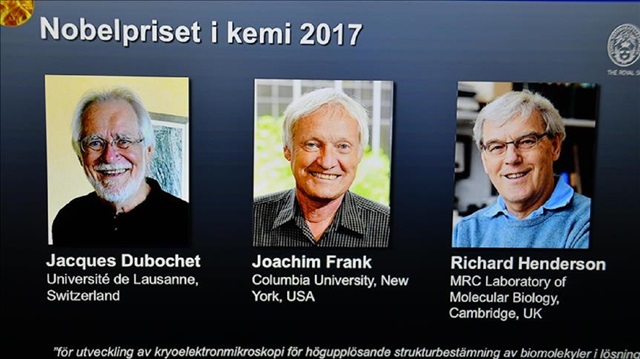
3 international researchers will share $1.1M prize from Royal Swedish Academy of Sciences for their advances
This year’s Nobel Prize in Chemistry was awarded on Wednesday to three scientists based in Switzerland, Germany, and the U.K for developing cryo-electron microscopy, which “simplifies and improves the imaging of biomolecules.”
Researchers Jacques Dubochet, Joachim Frank, and Richard Henderson will receive equal shares of the 9 million Swedish kronor ($1.1 million) prize announced by the Royal Swedish Academy of Sciences in Stockholm.
“This method has moved biochemistry into a new era,” the academy said in a statement on Wednesday.
“Researchers can now freeze biomolecules mid-movement and visualize processes they have never previously seen, which is decisive for both the basic understanding of life’s chemistry and for the development of pharmaceuticals,” it added.
Scottish molecular biologist Henderson managed to use an electron microscope “to generate a three-dimensional image of a protein at atomic resolution” in 1990. “This breakthrough proved the technology’s potential,” the statement said.
Frank, a German-born professor at Colombia University in New York, further developed the technology, making it generally applicable.
“Between 1975 and 1986 he developed an image processing method in which the electron microscope’s fuzzy two-dimensional images are analyzed and merged to reveal a sharp three-dimensional structure.”
Finally, Swiss-born Dubochet succeeded in adding water to electron microscopy.
“In the early 1980s, Dubochet succeeded in vitrifying water -- he cooled water so rapidly that it solidified in its liquid form around a biological sample, allowing the biomolecules to retain their natural shape even in a vacuum,” the statement added.
According to the Nobel Prize’s official website, prizes in chemistry have been awarded to 178 Nobel laureates since 1901. Last year's prize in chemistry was also awarded to three scientists quot;for the design and synthesis of molecular machinesquot;.
The 2015 prize went to Aziz Sancar, a Turkish-born chemist now working at the University of North Carolina in the U.S.


